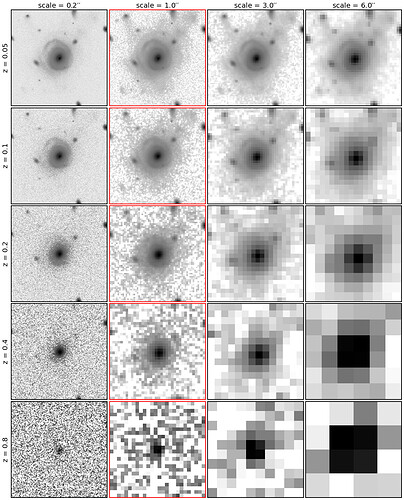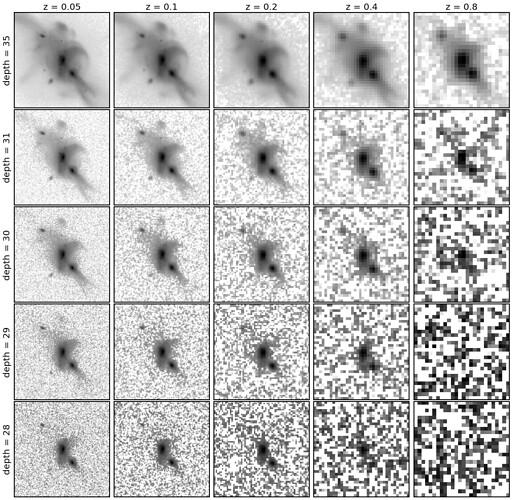Hi Everyone,
Please read below for a description or the postage stamps created for the LSST Galaxies LSB Challenge#4 project.
Scaling
Firstly, we discussed deciding on a fixed binning at our last meeting. From the continued discussion on slack, a binning of ~1" (i.e. similar to the PSF) seems to be optimal in terms of preserving details. The plot below shows the same object with different binnings along the x axis and different redshifts along the y axis.
It seems fairly clear to me that with much larger binning and gain in depth is counteracted by a loss of detail, but please comment if you do not agree.
Categories for classification
For the classifications, I have chosen the following categories which are shown in the example images below:
I think the best way to do the classifications if to have people count the number of instances of each of these categories they see in each image. Detailed classifications will be difficult for redshifts greater than z ~ 0.1, so I will also include a yes/no classification as to whether the object appears to be merging or disturbed.
Mock images
For each object I have produced postage stamps for with the combination of parameters detailed in the table below (plus a postage stamp for each orientation with SB_lim = 35 and z = 0.05):

The reason for choosing a range of depths is so we can make predictions over the lifetime of the survey rather than at the 10 year depth, plus the IMF we choose can effect the depth somewhat and there are a range of predicted values for the 10 year depth. The 35 mag SB limit is there to give us a kind of ground truth for the true number of tidal features that each object has. Altogether there will be around 10,000 postage stamps, so if we can get 50 people to volunteer, that would be 200 classifications each.
See the image below for the same object observed over a grid of depths and redshifts.
I have produced multiple versions of each postage stamp (.png format). Greyscale log scaled images (SB maps) with increasing depths (vmin=[27,29,33]). I think this helps give an idea of what depths the tidal features are at as well as giving better contrast for brighter tidal features close to the main galaxy. Secondly, I have produced g,r,i mock images according to the Lupton+2004 scaling. I think that together these make classification fairly easy without having to manually scale the .fits files.
I will treat permutation of the postage stamps as completely separate from each other and they will be assigned randomly to volunteers to classify without any information attached (e.g. they won’t be told the object ID, the depth or redshift).
Please comment here or email me if you have any comments or further suggestions.
I have already sent out an invitation to everyone in the challenge #4 mailing list to volunteer, so please let me know if you would like to help out or if you have any students who could also volunteer to help out).
Once we have finalised this, I may also send an email out to the wider galaxies WG to try and get some more volunteers, if it seems like we do not have enough people.
Thanks in advance,
Garreth



